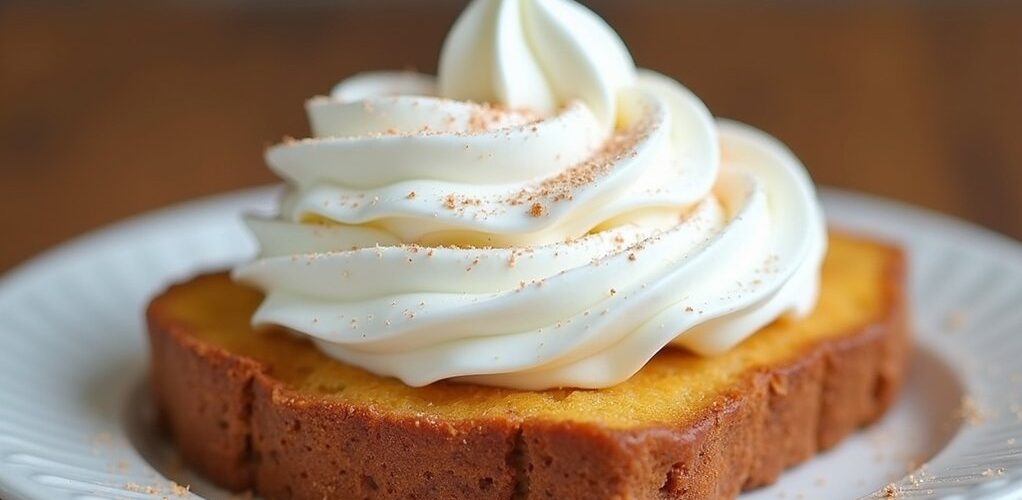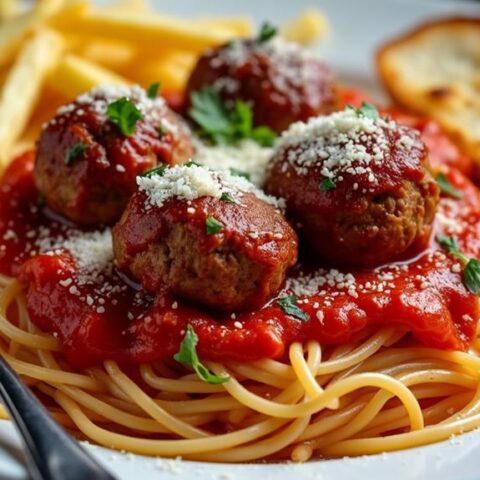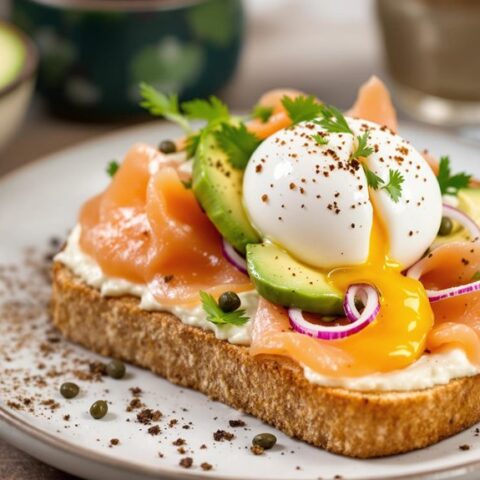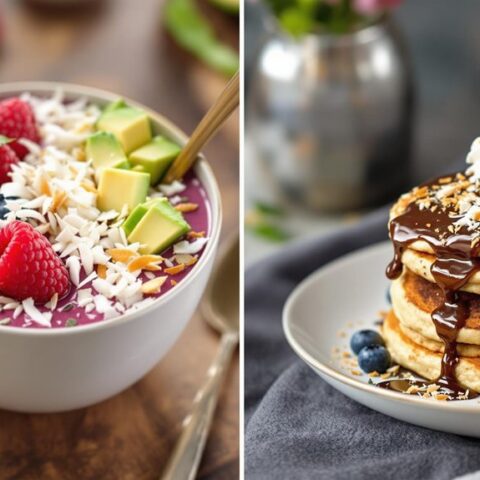
Cool Whip is not considered low-carb, containing approximately 3 grams of net carbs per tablespoon serving. This amount can quickly consume a significant portion of the typical 20-30 gram daily carb limit on ketogenic diets. The product also contains hidden ingredients like high fructose corn syrup and modified starch that may impact blood sugar levels and ketosis. Health-conscious consumers can explore keto-friendly alternatives, including homemade whipped cream using heavy cream and natural sweeteners, to better align with low-carb goals.
Key Takeaways
- Regular Cool Whip contains 3 grams of net carbs per tablespoon, which can quickly consume a significant portion of keto daily limits.
- Hidden ingredients like high fructose corn syrup and modified starch can spike blood sugar and potentially disrupt ketosis.
- Portion control is crucial, as consuming more than two tablespoons of Cool Whip may exceed daily carb limits for ketosis.
- Sugar-free varieties still contribute to overall carb intake and contain artificial sweeteners that may affect blood sugar levels.
- Making homemade whipped cream with heavy cream and sugar-free sweeteners offers a more keto-friendly alternative with cleaner ingredients.
Understanding Cool Whip's Carb Content
When evaluating whether Cool Whip fits into a low-carb diet, understanding its carbohydrate content becomes vital for making informed dietary choices. Regular Cool Whip contains approximately 3 grams of net carbs per tablespoon serving, which can greatly impact daily carbohydrate limits, especially for those following strict low-carb protocols.
The presence of high fructose corn syrup and modified starch in traditional Cool Whip makes it a challenging option for carb-conscious consumers.
While sugar-free varieties might seem like a better alternative, they still contribute to overall carbohydrate intake and contain artificial sweeteners.
Careful portion control becomes vital, as consuming more than two tablespoons could potentially disrupt ketosis in those following ketogenic diets.
Different Cool Whip formulations vary in their carbohydrate content, making label reading an important practice for managing carb intake.
Hidden Ingredients That Impact Ketosis
Beyond its obvious carbohydrate content, Cool Whip contains several hidden ingredients that can greatly impact ketosis and derail low-carb dietary goals.
While Cool Whip may appear low in net carbs per serving, its ingredient list reveals numerous problematic components for those following a keto lifestyle.
- High fructose corn syrup can trigger rapid blood sugar spikes
- Hydrogenated oils, including palm oil, may promote inflammation
- Modified starch contributes additional hidden carbohydrates
- Artificial ingredients and preservatives can interfere with ketosis
- The combination of these ingredients may slow fat adaptation
Including Cool Whip in a ketogenic diet could potentially lead to increased insulin release, a result of its high carbohydrate and sugar content, which contradicts the low insulin impact goal of keto.
These hidden ingredients make Cool Whip a questionable choice for maintaining ketosis, despite its seemingly modest carb count per serving.
Despite appearing low in carbs, Cool Whip's hidden ingredients can disrupt ketosis and compromise your low-carb dietary success.
Understanding these components is essential for making informed decisions about incorporating Cool Whip into a ketogenic eating plan.
Serving Size and Net Carb Calculations
Accurate measurement of Cool Whip servings becomes critical when following a ketogenic diet, as a single tablespoon contains 3 grams of net carbs.
Understanding portion sizes helps individuals stay within their daily carb limit of 20-30 grams while enjoying this topping in moderation.
Careful tracking of serving sizes guarantees that Cool Whip consumption aligns with ketogenic goals without unexpectedly exceeding carb allowances.
Measuring Portions Accurately
Successful portion control with Cool Whip requires precise measurement to maintain a low-carb lifestyle. When measuring portions accurately, it's vital to understand that one tablespoon contains 3 grams of net carbs per 9-gram serving.
Using proper measuring tools helps guarantee compliance with daily carbohydrate limits and maintains ketosis.
- Use a digital kitchen scale for precise gram measurements
- Employ standard measuring spoons for consistent portion sizes
- Check nutrition labels to verify carb content per serving
- Track portions in a macro calculator or food diary
- Clean measuring tools between uses for accurate measurements
Careful measurement prevents overconsumption and helps maintain ketosis.
Regular tracking of portions enables better understanding of daily carb intake, making it easier to stay within ketogenic diet parameters while still enjoying Cool Whip as an occasional treat.
Daily Carb Limit Impact
When incorporating Cool Whip into a ketogenic diet, understanding its impact on daily carb limits becomes essential for maintaining nutritional goals.
With 3 grams of net carbs per 2-tablespoon serving, Cool Whip can quickly consume a significant portion of the typical 20-30 gram daily carb limit followed by most keto dieters.
Careful monitoring of portion sizes is vital, as exceeding recommended servings can inadvertently push individuals over their carbohydrate threshold and potentially disrupt ketosis.
Using a keto diet calculator helps track how Cool Whip fits into the broader scope of daily macro requirements. This awareness enables better decision-making about incorporating Cool Whip into meals while staying within prescribed carb limits, particularly when consuming other carb-containing foods throughout the day.
Effects of Artificial Sweeteners on Low-Carb Diets
Artificial sweeteners in Cool Whip can affect blood sugar levels differently among individuals following low-carb diets, with some experiencing insulin responses that may impact their dietary goals. The body's tolerance for these sweeteners varies considerably, as certain people may encounter digestive issues or increased cravings when consuming sugar-free products. Those pursuing ketosis should carefully monitor their response to artificial sweeteners, as these substances can potentially influence ketone levels and overall metabolic performance on a low-carb eating plan. It's important to choose keto-friendly sweeteners with a low glycemic index, such as stevia or erythritol, to maintain stable blood sugar levels and support ketosis.
Blood Sugar Response Impact
Understanding the impact of artificial sweeteners on blood sugar levels is vital for individuals following a low-carb diet, as these substances can affect metabolic responses in unexpected ways.
Despite being marketed as sugar-free alternatives, artificial sweeteners can trigger complex physiological responses that may interfere with blood sugar management.
- Artificial sweeteners may stimulate insulin production despite their low carbohydrate content.
- Individual responses to sweeteners vary greatly, requiring personal monitoring.
- Changes in gut microbiota from sweetener consumption can affect glucose metabolism.
- High-fructose corn syrup in Cool Whip may disrupt blood sugar stability.
- Sweet taste receptors activated by artificial sweeteners may increase cravings and overall carb intake.
These factors make it important for those on low-carb diets to carefully evaluate their response to products containing artificial sweeteners, as the effects may undermine their dietary goals.
Individual Tolerance Varies
Perhaps the most challenging aspect of incorporating artificial sweeteners into a low-carb diet is the significant variation in individual responses to these substances.
While some people maintain stable blood sugar levels when consuming products containing artificial sweeteners, others may experience noticeable spikes and disruptions to their ketosis.
Individual tolerance to artificial sweeteners can manifest in various ways, from metabolic responses to changes in gut bacteria composition.
Some individuals report increased cravings for carbohydrates after consuming these sweeteners, while others maintain their low-carb goals without issue.
The key lies in personal monitoring and adjustment, as there's no one-size-fits-all approach.
Those following a low-carb lifestyle should pay attention to their body's reactions, keeping detailed notes about how different artificial sweeteners affect their progress and overall well-being.
Ketosis Effects Worth Monitoring
The effects of artificial sweeteners on ketosis require careful monitoring for individuals committed to maintaining a low-carb lifestyle.
Research indicates that these sweeteners can impact metabolic processes in various ways, potentially affecting the body's ability to maintain stable ketosis levels.
- Artificial sweeteners may trigger insulin responses that could disrupt ketosis maintenance.
- Individual tolerance levels vary greatly among different people.
- Changes in gut bacteria composition can occur with regular sweetener consumption.
- Blood sugar fluctuations may result from certain types of artificial sweeteners.
- Increased cravings for sweet foods might compromise low-carb diet adherence.
Understanding these effects helps individuals make informed decisions about their sweetener consumption while following a ketogenic diet.
Regular monitoring of ketone levels and careful observation of personal responses to artificial sweeteners can help maintain successful adherence to a low-carb lifestyle.
Making Your Own Keto-Friendly Whipped Cream
Creating a homemade keto-friendly whipped cream offers a delicious alternative to store-bought options while maintaining strict low-carb requirements. The process involves combining cold heavy whipping cream with sugar-free sweeteners and vanilla extract to create a smooth, creamy topping that aligns with ketogenic dietary goals. Keto-friendly dairy includes high-fat, low-carb options such as heavy whipping cream, which adds richness without disrupting ketosis.
| Ingredient | Amount | Purpose |
|---|---|---|
| Heavy Whipping Cream | 2 cups | Base texture |
| Liquid Stevia | 20 drops | Natural sweetener |
| Vanilla Extract | 1 tsp | Flavor enhancer |
The mixture should be whipped for approximately five minutes until soft peaks form, resulting in a perfectly textured topping. This homemade version contains healthy fats while eliminating processed additives, and when stored properly in the refrigerator, it remains fresh for up to one week.
Best Store-Bought Alternatives for Low-Carb Dieters
While making homemade whipped cream provides ideal control over ingredients, many individuals seek convenient store-bought alternatives that align with their low-carb lifestyle. Several manufacturers now offer sugar free Cool Whip alternatives and good whipped topping options that support low carb dietary goals.
Store-bought sugar-free whipped toppings now provide convenient low-carb alternatives for those seeking quick substitutes to homemade whipped cream.
When selecting a store-bought low-carb whipped topping, consider these key factors:
- Natural sweeteners like stevia or erythritol instead of artificial sweeteners or corn syrup
- Net carb content of 1-2 grams per serving for best low-carb compatibility
- Clean ingredient lists without harmful additives or preservatives
- Dairy-free coconut-based options for those seeking healthier fats
- Third-party verification of keto-friendly or low-carb certification
Brands like Truwhip and Whipped Cream Zero demonstrate that convenient, tasty alternatives exist for health-conscious consumers seeking low-carb options. Keto chocolate offers low-carb alternatives for sweets, typically sweetened with erythritol, stevia, or monk fruit.
Top Ways to Use Keto Whipped Toppings
As culinary enthusiasts explore innovative ways to maintain their low-carb lifestyles, keto whipped toppings emerge as versatile additions to countless sugar-free treats and beverages. From enhancing the richness of Keto Dark Chocolate Tart to adding luxurious creaminess to Low Carb Easy Pumpkin Cheesecake Cups, these toppings offer delightful ways to boost desserts. Creative applications include incorporating keto whipped cream into hot chocolate for a comforting drink, or mixing it with sugar-free jam for a unique peanut butter and jelly experience. Health-conscious individuals can experiment by blending in protein powder or matcha for nutrient-rich variations. For convenient portion control, freezing spoonfuls of keto whipped cream creates satisfying snack bites that align perfectly with low-carb dietary goals. Incorporating high-fat foods into your diet through keto whipped toppings provides essential nutrients and satiety, supporting ketosis and stabilizing blood sugar levels.
Tips for Incorporating Whipped Toppings While Staying Low-Carb
Successful incorporation of whipped toppings into a low-carb lifestyle requires strategic planning and mindful portion control. Understanding the serving size of Cool Whip and similar products is essential, as carbohydrates can accumulate quickly.
Mindful portion control and careful planning allow whipped toppings to fit seamlessly into a low-carb diet while managing carbohydrate intake effectively.
While sugar-free alternatives exist, creating homemade whipped cream offers the most control over ingredients and macronutrients.
- Monitor portion sizes carefully, limiting servings to 2 tablespoons
- Track daily carbohydrate intake to stay within ketosis range
- Choose sugar-free versions when possible, but review ingredients carefully
- Make fresh whipped cream using heavy cream and keto-friendly sweeteners
- Combine whipped toppings with low-carb fruits or desserts to maximize enjoyment while minimizing carbs
- Incorporate almond flour into your keto baking for a low-carb, high-fat option that complements the whipped toppings.
Reading nutritional labels and maintaining awareness of serving sizes guarantees whipped toppings can be enjoyed while adhering to low-carb dietary goals.
Frequently Asked Questions
Will Cool Whip Kick You Out of Ketosis?
Cool Whip can disrupt ketosis effects due to its carb content. For low carb desserts, choosing carb alternatives like homemade whipped cream with keto-friendly sweeteners helps maintain ketosis more effectively.
Is Cool Whip Ready to Eat?
Cool Whip is ready to eat straight from the container. While ingredients vary by variety, proper Cool Whip storage requires refrigeration. Those seeking alternatives can make homemade whipped cream for immediate consumption.
How Many Carbs Are in Cool Whip?
Cool Whip contains 3 grams of net carbs per 2-tablespoon serving. For lower carb desserts, alternatives like sugar-free whipped cream offer better carb content comparison, containing less than 1 gram per serving.
What Is the Healthiest Cool Whip?
Sugar-Free Cool Whip offers the healthiest commercial option, containing fewer carbs and calories. However, homemade whipped cream using natural ingredients provides superior nutritional value among low carb alternatives for topping desserts.
Conclusion
While Cool Whip contains fewer carbs than many dessert toppings, it may not align perfectly with strict low-carb diets due to its corn syrup and artificial ingredients. Health-conscious consumers can opt for homemade whipped cream using heavy cream and keto-friendly sweeteners, or choose specialized low-carb alternatives. By understanding serving sizes, checking ingredients carefully, and making informed choices, those following low-carb lifestyles can still enjoy creamy toppings without compromising their dietary goals.









No Comments